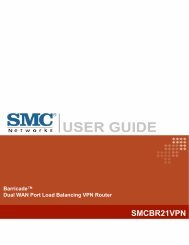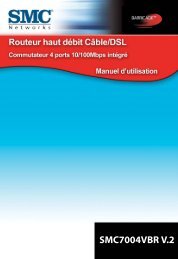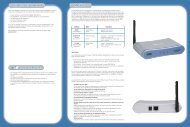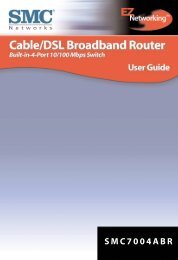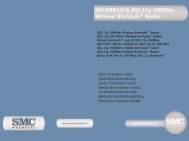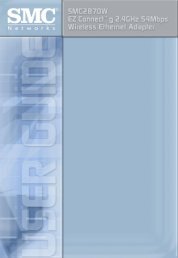TigerSwitch 10/100/1000 - SMC
TigerSwitch 10/100/1000 - SMC
TigerSwitch 10/100/1000 - SMC
You also want an ePaper? Increase the reach of your titles
YUMPU automatically turns print PDFs into web optimized ePapers that Google loves.
VLAN CONFIGURATION<br />
in one or more VLANs, but the device at the other end of the link does<br />
not support VLANs, then you must add this port as an untagged port (that<br />
is, a port attached to a VLAN-unaware device).<br />
VLAN Classification – When the switch receives a frame, it classifies the<br />
frame in one of two ways. If the frame is untagged, the switch assigns the<br />
frame to an associated VLAN (based on the PVID of the receiving port.<br />
But if the frame is tagged, the switch uses the tagged VLAN ID to identify<br />
the port broadcast domain of the frame.<br />
Port Overlapping – Port overlapping can be used to allow access to<br />
commonly shared network resources among different VLAN groups, such<br />
as file servers or printers. Note that if you implement VLANs which do<br />
not overlap, but still need to communicate, you can connect them by using<br />
a Layer-3 router or switch.<br />
Port-based VLANs – Port-based (or static) VLANs are manually tied to<br />
specific ports. The switch’s forwarding decision is based on the destination<br />
MAC address and its associated port. Therefore, to make valid forwarding<br />
or flooding decisions, the switch must learn the relationship of the MAC<br />
address to its related port—and thus to the VLAN—at run-time.<br />
However, when GVRP is enabled, this process can be fully automatic.<br />
Automatic VLAN Registration – GVRP (GARP VLAN Registration<br />
Protocol) defines a system whereby the switch can automatically learn the<br />
VLANs to which each endstation should be assigned. If an endstation (or<br />
its network adapter) supports the IEEE 802.1Q VLAN protocol, it can be<br />
configured to broadcast a message to your network indicating the VLAN<br />
groups it wants to join. When this switch receives these messages, it will<br />
automatically place the receiving port in the specified VLANs, and then<br />
forward the message to all other ports. When the message arrives at<br />
another switch that supports GVRP, it will also place the receiving port in<br />
the specified VLANs, and pass the message on to all other ports. VLAN<br />
requirements are propagated in this way throughout the network. This<br />
allows GVRP-compliant devices to be automatically configured for VLAN<br />
groups based solely on endstation requests.<br />
2-43



